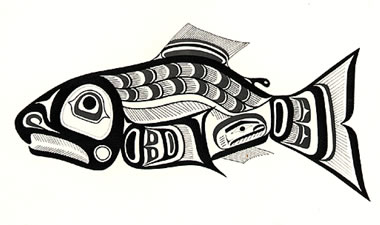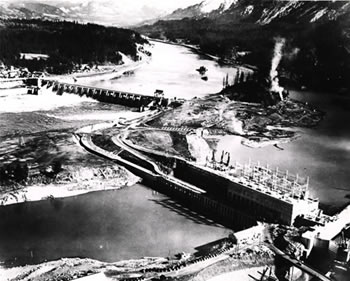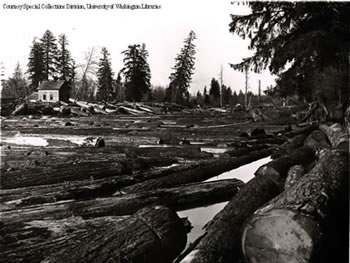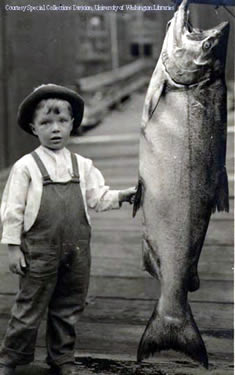
Lesson Two: To Whom Does the Pacific Northwest Belong?
"Kwagulth the Salmon," (left) print by Northwest Native artist Tony Hunt. © 1976 (Hall, Edwin S., Blackman, Margaret B., and Rickard, Vincent. Northwest Coast Indian Graphics. Seattle, University of Washington Press, 1981. p. 64.)
The previous lesson asks who belongs in the Pacific Northwest, and addresses the question by considering the image of Californians, who have come to serve as a rallying point for people in Washington, Idaho, and Oregon. Many residents from these three states, who hardly see eye to eye on every issue, have in recent years tended to agree upon a mutual aversion to Californians. Their stereotypical views of people from the Golden State may not have been accurate, but they have nonetheless contributed to a stronger sense of regional identity. People in the Pacific Northwest seem to know who they are because they have a strong (if largely dubious) sense of who they are not—Californians.
Besides Californians, the other increasingly powerful foil for regional identity in recent years has been salmon. In this case, however, in contrast to Californians, salmon seem to stand for all that is good about the Pacific Northwest (and perhaps all that appears to be endangered by the influx of people from south of the 42nd parallel). The wild runs of Pacific salmon are an indigenous, homegrown species. Unlike recent immigrants, they are native to the Northwest. In fact, they are of nature itself, spawning in freshwater streams. Salmon appear to bind the region together by crossing the lines that divide it. For example, they live on both sides of the Cascade Mountains, and therefore stand as something that the eastern and western halves of the Northwest can claim in common. Moreover, the salmon apparently cross human divides as well as geographic ones. Although Indians and non-Indians have fought one another for years over access to the runs of fish, the iconic salmon is something that the two groups share. One consequence is that artwork portraying the fish by both Indian and non-Indian artists has grown quite popular throughout the region. And much is made of the newfound cooperation between Indians and non-Indians as they cooperate in trying to save the dying runs of wild salmon.
In the world of symbols, the salmon are seen as uniting the Pacific Northwest. Thus the journalist Timothy Egan, in The Good Rain: Across Time and Terrain in the Pacific Northwest (1990), writes that "The Pacific Northwest is simply this: wherever the salmon can get to." And because they are so important to our regional identity, it is our duty to save them. Will Stelle, head of the Northwest office of the National Marine Fisheries Service, explains: "Salmon are part of the heart and soul of the Pacific Northwest. They have defined its history and its culture and hopefully its future." The clear implication is that if the wild runs of Pacific salmon are allowed to die, the region as a special place—as a distinctive part of the United States—will die, too.
The symbol of the salmon, like the symbol of the Californian, has a lot of power in the Pacific Northwest. But like the symbolic Californian, the symbolic salmon probably masks or obscures more about the Pacific Northwest than it reveals. Behind the warm and fuzzy notion of Salmon Are Us lies a set of much more divisive issues. Can the wild runs of salmon be saved? Can the region and the nation afford to spend what it will cost to save the threatened species? Who will gain and who will lose from plans to salvage runs of salmon?
Such questions lead to an even bigger concern: Who "owns" the Pacific Northwest, and who therefore has a stake and a voice in how questions about the future of salmon are answered? The previous lesson asked who belongs in the Pacific Northwest. This lesson asks to whom the Pacific Northwest belongs.
One of the major attractions of the salmon as a regional symbol is that it is indigenous; it "belongs" to the region and all its peoples. And, the implication is, all the people of the Northwest belong to it. Because preserving the salmon means preserving ourselves, we tend to assume that it is up to us to save the species of fish, and that what Pacific Northwesterners can manage to do about the salmon should and will be accepted by others. Legal and political and economic realities, however, suggest otherwise. Saving the salmon is a matter much more complicated than having Northwesterners simply agree to preserve the species that they all love. The answer to the question of to whom does the Pacific Northwest belong is equally complex.
As I write these words in spring 1998, numerous runs of Chinook salmon in western Washington have just been nominated for inclusion on the federal government's list of endangered species. This action has heightened the region's anxiety about preserving salmon. It confirms, of course, what is already widely known—the wild runs of salmon are disappearing. But it also raises another specter: if Washington cannot develop a credible plan to preserve endangered species of salmon, the federal government will step in and impose its own plan on the state. The fear, of course, is that the federal government will prove insensitive to local needs.
The question of saving the salmon is closely tied to the issue of who controls the region, or "to whom the Pacific Northwest belongs." Officials in Washington state worry about possible federal efforts to save salmon intruding upon state and local affairs. They suggest that the region belongs to its residents, not federal officials, and those residents ought to be permitted to solve their own problems. But in fact the federal government is intimately involved in all questions of the salmon's status; it is, after all, a federal law, the Endangered Species Act of 1973, that has raised the current dilemma. Moreover, there is a long tradition of federal involvement in Pacific Northwest salmon. In 1974 a federal judge in Tacoma, George Boldt, handed down a landmark decision that interpreted treaties between Indians and the U.S. government during the 1850s. Boldt determined that, based on the language of the treaties, Indian peoples in western Washington had a right to 50% of the commercial catch of all salmon, even though the native population amounted to no more than 1.5% of the population. In this way, and many others, the federal government has long played a role in determining who gets what natural resources in the Pacific Northwest.

In spring 1997, a court case filed in Oregon revealed the complexity of modern squabbles over salmon. The state of Oregon filed suit against the U.S. government, trying to get it to live up to federal laws requiring protection of threatened species. More specifically, Oregon wanted the federal agencies the manage the flow of the Columbia and Snake Rivers so as to spill more water over dams in order to improve young salmon's odds of survival. Oregon was supported by representatives from the state of Washington, and by environmental groups, commercial fishing interests, and even some federal agencies sympathetic to more salmon protection (the Fish and Wildlife Service and the National Park Service). Unified against the suit were other, more prominent agencies of the U.S. government (the Army Corps of Engineers, Bureau of Reclamation, and Bonneville Power Administration or BPA), the states of Idaho and Montana (which benefit more from not spilling more water over the dams), and an assortment of private interests (inland shipping interests, irrigated farmers, and aluminum companies that rely on cheap BPA electricity) who fear they would lose money if the river system is managed differently. Each of the parties to the lawsuit, of course, had a different answer to the question of to whom does the region and its salmon belong. And, as if disagreements within and between the states of the Pacific Northwest were not enough, there have long been even wider disputes under way. The United States and Canada have since the late 19th century been arguing over which country's fishers have rights to salmon runs passing through one nation's salt waters on their way to the other's spawning streams.
Even though the Bonneville Dam (above right) and others along the Columbia and Snake Rivers have fish ladders, the dams' size and function has created a serious obstruction to migrating salmon. (University of Washington Special Collections, Neg. #15581.)
Disputes over salmon anticipate a variety of historical questions to be covered in this course. At one time, Indian groups occupied the Pacific Northwest by themselves. They too disagreed among themselves over who controlled what parts of the region. When non-Indian peoples arrived to explore, exploit, and occupy the region, they came representing different European and North American nation states—Spain, Britain, Russia, the United States, and Canada all claimed at least a portion of the Pacific Northwest at some time. They argued extensively over the question of to whom the Pacific Northwest belonged, seeing it as a matter of international rivalry. These nations also set about claiming territory from native peoples—resulting in, among other things, the treaties that reserved for Indians one-half of the commercial salmon catch. Within the American part of the Pacific Northwest, territories and states evolved, each claiming a portion of the region and each establishing a distinctive government and a series of counties and towns. All of these occupations gave a variety of governments a claim to the Pacific Northwest.
One answer to the question, "to whom does the Pacific Northwest belong," then, is government. Consider that the federal government owns 29.5% of the land in Washington, 52.5% of the land in Oregon, and 63.7% of the land in Idaho. Although Northwesterners may resent federal intervention in the salmon crisis and their other affairs, it is no accident that the U.S. government looms so large in the region. It is the largest landholder, and it is obligated to protect and manage its lands in the interests of all fifty states, not just the Pacific Northwest. In a sense, people from Georgia and New York and South Dakota "own" parts of the Pacific Northwest, because such lands as national parks and national forests are managed in their name and for their benefit. The U.S. government, as another example, determined unilaterally (and secretly) between 1943 and 1987 just how the lands and resources at the Hanford nuclear reservation would be managed, based primarily upon the needs of national security. The powers of the federal government are further enhanced by its special relationship to certain lands. Only the United States, for example, has the power to treat with Indian peoples, and the 2 million acres of Washington state set aside as Indian reservations (as of 1989) are managed by Indians and federal agencies, not by state or local officials. And only the federal government has the power to negotiate treaties with other nations, so when Washingtonians clash with British Columbians about land-use or salmon-rights issues, resolution of the dispute requires federal interaction with the nation of Canada. As another example, federal investment in the Columbia Basin Project and the various dams on the river and its tributaries give the U.S. government an extraordinary role in managing the river system. When it considers the fate of salmon in that system, it must take into account the interests of all fifty states, and not just those of Oregon, Idaho, and Washington. In short, through federal ownership, significant parts of the Pacific Northwest quite literally belong to a lot of people who do not live in the region, and they are in many ways managed by people and policies centered in "the other Washington," the nation's capital.

The federal government, of course, is hardly the only party to whom the Pacific Northwest belongs. Take a look at the forest lands in Washington state (one of the topics covered in William Dietrich's The Final Forest). The Evergreen State contains about 44 million acres; roughly half of those can be classified as forest land. Slightly more than half of this forest land (50.6%, or about one-quarter of the entire state) is publicly owned. The U.S. Forest Service owns and manages 28.4% of the publicly owned forest; the U.S. Bureau of Indian Affairs own another 8.9%; the state Department of Natural Resources owns another 10.3%; and counties and towns own the remainder of the publicly held forest. Private owners possess 49.4% of the forest, and they are divided roughly in half, between big corporate and smaller owners.
Let us think a minute about the forest land owned by big companies. Most of those companies are publicly traded firms, with investors or shareholders located around the world. The companies, and therefore the forest lands of Washington, are thus managed for the benefit not of residents of the Pacific Northwest but rather of those people who owns shares in the companies who own the forest land. In this way, too, much of Washington and the Pacific Northwest quite literally belongs to people who live outside the region. Because owners of forests are affected by the salmon problem (erosion of forest land is one of the big contributors to destruction of salmon-spawning habitat), they have a stake and a voice in problem.
Logs on the Humptulips River (above) after the floods of 1909, Grays Harbor County. (University of Washington Special Collections, Neg. #15684.)
Much of Washington's land, of course, is privately. Parcels of the Pacific Northwest, in other words, quite literally belong to specific individuals and families. However, as land owners are increasingly finding out, their rights to the property they own are not unfettered. (This is a subject taken up in William Kittredge's essay "Owning It All.") In the beginning of the 1990s, to give one example, the state of Washington passed relatively stringent growth management legislation which tried to limit urban sprawl in order to protect farmland, wetlands, and wilderness. (Oregon had had similar laws on the books for more than twenty years.) The new laws limited what private owners could do with their property. If a farmer wants to sell her land to a developer and retire to Arizona on the profits, or a timber company wishes to convert a forest into a housing development, the right to do so is now limited. The state can prevent certain kinds of land developments now in order to prevent damage to wetlands, keep farmland in production, preserve old-growth forest and certain animal species' habitat, and prevent soil erosion that might destroy salmon-spawning streams. The state has determined, in other words, that it and all its residents have a heightened interest in how land is to be used; to prevent injury to the environment it is prepared to interfere with what owners of land can do with their property, which clearly can reduce the value of that property. In response to this abridgment of property rights, land owners in the eastern portions of King, Snohomish, Skagit, and Whatcom counties are talking about seceding and forming their own counties in order to escape the less permissive land-use regimes associated with big urban areas (and liberal environmental voters). As the meaning of property lines changes, some people want to redraw political lines, too.
* * * *
All of this is to say that the question of to whom does Washington belong is a complicated one. In dealing with the issue of endangered species of wild Pacific salmon, there is a tendency to want to say that these are "our" salmon and that "we" in the region are the ones who will solve the problem. But clearly the salmon (and the forests and the rivers and so much else) do not belong simply to "us," and the means required to preserve them will involve the other states of the union operating through the federal government, and other nations who participate in the fisheries of the North Pacific. Moreover, even if the salmon issue were left up solely to residents of the Pacific Northwest, those residents are so obviously divided among themselves that they would find it very hard to arrive at a consensus that would do the salmon much good. Intervention by federal officials may prove quite useful—although there are no guarantees of that.
Whether they like it or not, people in the Pacific Northwest ought to be used to the influence of outsiders. For much of its history, the region has struggled to deal with the fact that external entities have exerted significant power over it. Since we have been discussing the matter of regional identity, let me offer two examples relating to the topic. The idea of "the Pacific Northwest" was popularized for the first time not by residents of the region but by big railroad companies, headquartered back East. As transcontinental lines were completed during the 1880s and 1890s, railroads publicists launched campaigns to direct attention to the states of Idaho, Oregon, and Washington, and in doing so lumped them together as a single place called the "Great Northwest" or the "Great Pacific Northwest." One set of railroad publicists explicitly meant "to introduce the word 'Pacific Northwest' into the popular vocabulary—to make it convey a definite, clean-cut meaning. To make it stand for an idea." Well before most residents of Washington, Oregon, and Idaho were prepared to see themselves as belonging to the same region, outside investors and landowners were lumping the three states together and selling them to the world.
Another outside power, the federal government, contributed to the sense of region, too. It did this in part by creating a "Pacific Northwest region" as an administrative unit for such bureaucracies as the National Park Service or the Army Corps of Engineers. It also created an agency specifically for the region—the Bonneville Power Administration—when it began marketing the kilowatts generated by federally funded and managed dams on the Columbia River during the 1930s. Like the railroad companies, the federal government had less intrinsic attachment to specific states and localities of the Northwest; it instead saw the region as a single hydroelectric system to be managed, and like the railroads it forced the disparate parts of the Northwest to coordinate with one another more than they ever had. In other words, the whole concept of the Pacific Northwest is to a large extent the invention of outsiders, of people whose offices were in Washington, D.C. or New York City or St. Paul, Minnesota, rather than in the Pacific Northwest itself. The idea of a region has been somewhat imposed on us. The emergence of Californians and salmon as regional icons represents residents' recent effort to assert their own more homegrown understanding of what the region means—and, implicitly, to whom the region belongs.
 Let me conclude by restating that the meanings so popular today make more sense at a symbolic level than they do in actuality. I have suggested already that there are problems with portraying the Pacific Northwest as the antithesis of California. (Washington, of all the states in the American West, most resembles the Golden State—in its urban orientation, its high-tech industry, its reliance on U.S. defense spending, and other traits. I propose, in fact, that Washington is more like California than it is like Oregon.) Let me suggest as well that there are problems with employing salmon as the regional icon.
Let me conclude by restating that the meanings so popular today make more sense at a symbolic level than they do in actuality. I have suggested already that there are problems with portraying the Pacific Northwest as the antithesis of California. (Washington, of all the states in the American West, most resembles the Golden State—in its urban orientation, its high-tech industry, its reliance on U.S. defense spending, and other traits. I propose, in fact, that Washington is more like California than it is like Oregon.) Let me suggest as well that there are problems with employing salmon as the regional icon.
We can say with Egan that the Pacific Northwest is "wherever the salmon can get to." But wild runs of Pacific salmon get to plenty of places outside the borders of the Pacific Northwest—including streams draining into the Arctic Ocean, rivers in Russia and Korea and Japan, and watersheds in Chile and New Zealand and Australia. They even spawn in California and the Great Lakes! Yet there are some parts of Washington, Idaho, and Oregon where the salmon have never been able to get to, unless they are trucked in, because some watersheds (such as those in southeastern Oregon that are part of the landlocked Great Basin) cannot support anadromous fish.
Salmon are thus an imperfect marker of regional identity. Many of the fish, furthermore, are not as "natural" and "native" to the region as we take them to be. A great deal of the salmon consumed in the Northwest today is in some fashion "manmade." This includes the Atlantic salmon so readily available at grocery stores—which are farm-raised—and the many hatchery-spawned fish, whose numbers and habits actually contribute to the decline of the wild runs of salmon. With these additions to the "natural" stock of salmon, Pacific Northwesterners have been able to have their icon and eat it, too. How much longer they will enjoy such a luxury is open to question. Should Northwest runs of wild Pacific salmon become extinct, we need to ask, will the region's special identity become extinct, too?
Learning to Fish in the Northwest (right) A Northwest child poses with a freshly caught salmon. (University of Washington Special Collections, Fisheries File.)
| Course Home | Previous Lesson | Next Lesson |